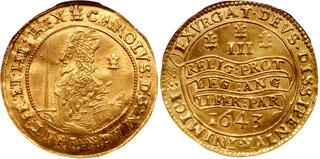| Ira & Larry Goldberg Coins & Collectibles > Auction 137 | Auction date: 29 January 2024 |
| Lot number: 1122 Price realized: 45,000 USD (Approx. 41,679 EUR) Note: Prices do not include buyer's fees. | Show similar lots on CoinArchives Find similar lots in upcoming auctions on |
| Lot description: Great Britain. Triple Unite, 1643. S-2726; N-2383. 26.71 grams. Charles I, 1625-1649. Oxford mint. Crowned bust left, holding sword and branch, scarf behind king's shoulder. Reverse; Scrolled "Declaration." Plume mintmark. Lustrous and especially choice for issue, on a full flan with excellent sharpness for this massive piece, part of obverse legend at bottom doubled but otherwise crisp. Very rare, especially in high grade. PCGS graded Uncirculated Detail (Repaired). Estimated Value $25,000 - UP After the peaceful early years of his reign, King Charles I's sense of his absolute God-given right to rule England was challenged by his Parliament. He clashed many times with his legislators. His marriage to the Catholic princess Henrietta Maria of France led to revolts in Ireland and Scotland. Aristocrats steadily turned against Charles and in January 1642 members of the "Long Parliament" (the longest lasting one) seized power, forcing Charles to march north to escape violence. He reached Nottingham by late August, then went on to Oxford, where he set up court in October and began to make ready for civil war. At one of the war's early skirmishes, at Wellington, the king urged support when he made what has come down through history to be called the Wellington Declaration. He vowed to uphold and enforce England's three greatest traditions-the Protestant religion, the laws of England, and the liberty of Parliament-thereby seeking to dissuade all opponents that he was pro Catholic, or a monarch who might disavow laws for his personal convenience. The Civil War ran intermittently from the fall of 1642 until its horrid conclusion in early 1649. All during that time, coinage was solely the king's prerogative, traditionally his right and his alone in the kingdom; history abounds with stories of college plate and other local riches being converted to money bearing the king's name, perhaps most famous of all his massive triple unites, which were the ultimate images of his monetary power and by far his largest coins. Most of these coins were used to pay his generals and purchase supplies, arms, rents and other necessities, not least of which was loyalty. Within six years of when this impressive coin was minted, Charles was captured, tried for treason by his enemies, and beheaded in January 1649. Never before had an English king been so treated. At his demise, the ancient divine right of kings effectively ended across the land. Never again would a king of England rule with absolute power. He had relinquished the sword he is depicted as holding on this coin. In a way, today's collectors may still hold the king's hopes in their hands, here in this golden emblem of its age. Ex Dr Jacob Y. Terner Collection (by private treaty to the Millennia Collection); Ex Goldberg "Millennia" Sale 46, May 26, 2007, lot 306, previously in NGC holder graded MS-62, price realized $100,000. |  |


